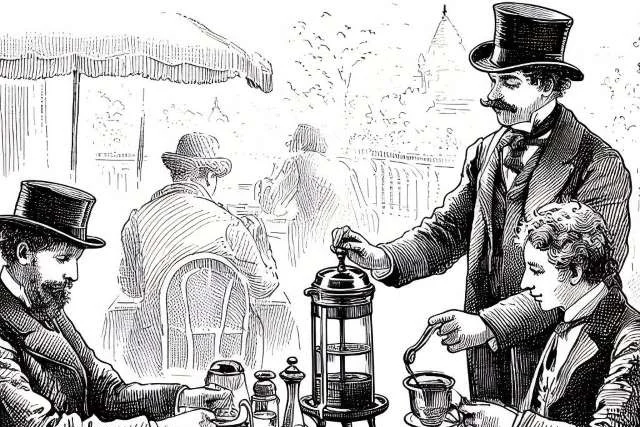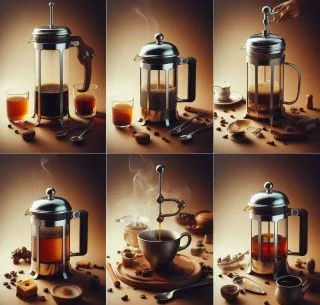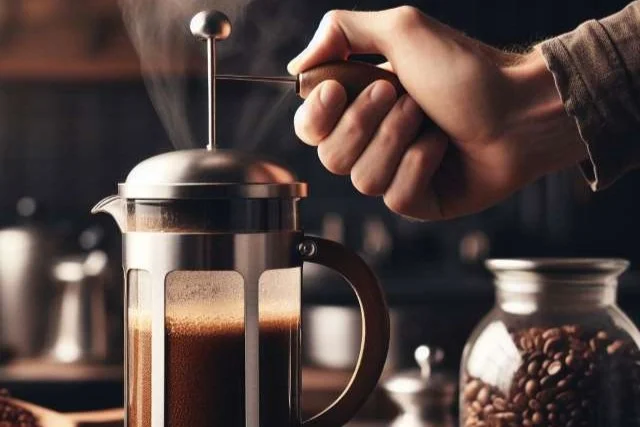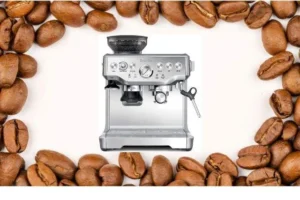Crafting the Perfect Cup: How to Make French Press Coffee
French press coffee, also known as cafetière or plunger coffee, is a classic manual brewing method that produces a bold, flavorful cup of coffee by steeping coarsely ground coffee beans in hot water. The French press has remained popular for decades and offers coffee lovers an immersive, hands-on brewing ritual.
How to Make Frenck Press Coffee: Key Takeaways
- French Press Brewing: Learn the essential steps for making French press coffee, including water temperature, grind size, and brewing time.
- Quality Coffee Beans: Choose high-quality, whole coffee beans from specific origins and roasts for the best French press results.
- Troubleshooting and Tips: Find solutions to common issues and discover useful tips for improving your French press brewing.
- Sustainability: Embrace the eco-friendliness of French press, reducing waste and promoting whole beans for a sustainable coffee experience.
A Brief History of the French Press

The French press has a long, rich history spanning several centuries. Here are some key points in the evolution of this iconic brewing device:
- 19th century: The earliest French press designs emerged in France in the 1800s. Metal plungers were used to push coffee grounds to the bottom of a pot.
- 1929: Italian designer Attilio Calimani patented the first modern French press featuring a mesh filter. This improved design separated grounds from the coffee liquid.
- 1950s: The French press was introduced to a wider audience at the Housewares Show in Chicago. New models appeared with glass rather than metal pots.
- 1960s: Its popularity grew among coffee connoisseurs who loved the richer, oilier mouthfeel of French press coffee.
- 1970s: The French press became a staple in many American and European kitchens and coffee shops.
- Today: French presses are manufactured globally. They are praised for their simplicity, quality brews, and eco-friendly aspects.
How a French Press Works
A French press might look simple, but there are some ingenious design features that enable it to brew excellent coffee. Here’s a breakdown of how it works:
Components
- Cylindrical glass or stainless steel pot (beaker): This is where the magic happens. Hot water and coffee are combined here.
- Plunger: A rod with a circular filter at one end that presses the grounds to the bottom when brewing is complete.
- Lid: Covers the top of the beaker to retain heat while coffee steeps. Has a hole for the plunger rod.
- Filter screen: A round stainless steel or mesh screen that separates grounds from liquid when plunging.
The Brewing Process
- Boil water and grind coffee beans to a coarse consistency.
- Add ground coffee to the empty beaker, then pour in hot water.
- Let the coffee steep for 4 minutes. Timing is key for optimal extraction.
- Slowly press the plunger down to filter grounds to the bottom.
- Pour coffee into your cup, add milk/sugar if desired, and enjoy!
Choosing the Right Coffee Beans

Great coffee starts with quality beans – freshly roasted whole beans, not pre-ground. Here are some tips for selecting beans for French press:
- Origin: Choose single-origin coffees from reputable regions like Ethiopia, Costa Rica, Colombia or Kenya. Avoid cheap commercial blends.
- Roast: Medium or dark roasts work best to stand up to the immersion brewing. Light roasts can taste weak.
- Whole beans: Grind beans right before brewing to maximize freshness and flavor.
- Flavor notes: Nutty, chocolaty or caramel notes are delicious in a French press.
- Fair trade & organic: Support sustainable growing practices when possible.
| Type of Bean | Good for French Press? |
| Brazilian Peaberry | Yes – bold, intense |
| Sumatran | Yes – rich, earthy notes |
| Honduran | Yes – balanced acidity |
| Colombian | Yes – medium roast brings out flavor |
| Ethiopian light roast | No – may taste under-extracted |
Grind Size Matters
Using a coarse grind is absolutely vital for proper French press brewing. Why?
- Large ground coffee particles allow water to flow freely between them.
- Tiny particles from fine grinds clog the filter and over-extract.
- Coarse grinds fully immerse in water but don’t release excessive oils.
Ideally, use a burr grinder for an even grind texture. Aim for a grind size similar to kosher salt grains. Some handy benchmarks:
- Sea salt: Too fine, avoid!
- Kosher salt: Perfect coarseness for most presses.
- Peppercorns: A tad too coarse.
- Ice cubes: Way too large and uneven.
Water Temperature

Heating water to the optimal temperature range is crucial for extraction and flavor in French press:
- 195°F to 205°F (90°C – 96°C) – This is the ideal brewing temperature for French press. Lower temp = weak coffee. Higher = bitterness.
- Use a kettle – Pouring hot water straight off boil is too hot. Let it sit 30 seconds off heat.
- Pre-heat press – Warm up the empty beaker with hot water while the kettle heats. Dump water before adding grounds.
Also, make sure your water tastes great on its own. Good filtration improves flavor. Pure spring water is ideal. If using tap water, filter it to remove chlorine and other compounds.
Coffee-to-Water Ratio
There are no hard rules for how much coffee or water to use in a French press. This chart offers general guidelines:
| French Press Size | Coffee (g) | Water (mL) |
| 3 Cup/12 oz | 42g | 340mL |
| 8 Cup/34 oz | 56g | 450mL |
| 12 Cup/48 oz | 84g | 675mL |
- Use 2 tablespoons of coffee per 6 oz of water as a basic ratio. Adjust to taste.
- Don’t overfill the beaker: leave room for foam and the plunger.
- Add more coffee for bolder brews or less for milder coffee.
Step-by-Step Brewing Guide
Follow this tried-and-true method for foolproof French press coffee:
- Boil Water: Heat filtered water until just boiling, then let sit for 30 seconds. Use a kettle with a built-in thermometer if possible.
- Grind Beans Coarse: Grind beans just before brewing. Use a burr grinder if available for even particle size.
- Add Coffee Grounds: Put ground coffee into the empty French press beaker. Use 2 tbsp per 6 oz water.
- Pour Water into Press: Slowly pour heated water into press. Leave a few inches at the top for foam.
- Stir Coffee: Gently stir coffee grounds to ensure full saturation.
- Put Lid On: Place the lid on top of the beaker to retain heat.
- Let Steep: Set a timer for 4 minutes. Start timing as soon as you finish pouring water.
- Plunge Slowly: When the timer goes off, press the plunger straight down very slowly to push the grounds to the bottom. Go too fast and you’ll stir up sediment.
- Pour and Enjoy: Pour coffee into your favorite mug. Add milk or sugar if desired. Savor the robust flavors!
Troubleshooting French Press Issues
| Problem | Cause | Solution |
| Bitter, over-extracted coffee | Coffee ground too fine<br>Steeped too long<br>Water too hot | Use a coarser grind<br>Steep for just 4 minutes<br>Lower water temp to 195° – 205°F |
| Weak, under-extracted coffee | Coffee ground too coarse<br>Not enough coffee<br>Water too cool | Use a slightly finer grind<br>Increase coffee amount<br>Ensure water is 195° – 205°F |
| Sediment in cup | Plunged too fast or roughly | Plunge slowly and smoothly |
| Coffee tastes sour | Under-extraction from coarse grind | Try slightly finer grind |
| Cloudy coffee liquid | Fine particles in grind | Improve grinder for consistent coarse grind |
Must-Have French Press Accessories

- Kettle with thermometer: Crucial for heating water to the right temp
- Burr coffee grinderL Even coarse grinding for perfect brews
- Timer: Essential for timing the 4-minute steep time
- Bean storage container: Keeps whole beans fresh until grinding
- Coffee scale: Weighs out perfect portions for any press size
Cleaning and Caring for Your French Press
To keep your French press in tip-top shape:
- Rinse parts after each use: Don’t let coffee residue dry on.
- Disassemble and wash weekly: Use a mild detergent on the beaker, lid, and filter screen.
- Replace filter screen annually: Old screens allow sediment to pass through.
- Descale monthly: Prevent mineral buildup with vinegar or descaling powder.
- Avoid dishwasher: Handwashing preserves components better.
French Press vs. Drip Coffee
French press and drip coffee offer very different experiences. Here’s how they compare:
Taste
- French press: Rich, gritty, robust
- Drip: Clean, bright, papery
Brewing Time
- French press: 4-minute steep
- Drip machine: 5-10 minutes
Convenience
- French press: Manual, hands-on process
- Drip machine: Automated, push-button
Waste
- French press: No disposable filters
- Drip: Many paper filters used
Price
- French press: Affordable, under $50
- Drip machine: Wide range, $40-$1000+
Both methods make delicious coffee. Choose based on your preferences for taste, time, and hands-on brewing!
The Pros and Cons of French Press

Advantages
- Strong, bold coffee with rich mouthfeel
- Greater control over the brewing process
- Portable and compact
- Affordable price point
- Reusable – no disposable filters
- Easy to clean
Disadvantages
- Sediment at the bottom of the cup
- Not as convenient as drip or pod coffee makers
- Coffee cools faster than some brewing methods
- Multiple parts to disassemble and wash
- Press size limits how much you can brew
French Press for Tea
Yes, you can easily brew loose-leaf tea in a French press! Follow a similar method:
- Use 1 tablespoon of tea leaves per 8oz of water. Adjust stronger or weaker.
- Heat water to 170°F – 185°F for black tea, cooler for green tea.
- Steep for 3 to 5 minutes depending on the tea variety.
- Press the plunger to filter out leaves before pouring.
Some wonderful teas for French press:
- Black teas – Breakfast blends, Earl Grey, chai
- Herbal teas – Chamomile, rooibos, mint
- Green tea – Sencha, matcha, genmaicha
The Global Popularity of French Press
The French press is beloved all over the world. People customize it with local ingredients:
- Australia: Adds eucalyptus for a unique herbal flavor
- Turkey: Brews a thick Turkish coffee concentrate called tavuklu
- Vietnam: Drips iced French press coffee over sweetened condensed milk
- Cuba: Sweetens strong pressed coffee with sugar to make Cuban coffee or cafecito
- Morocco/North Africa: Flavors coffee with spices like cinnamon, anise, cumin
- France: Serves café filtre, a strong black coffee, in bowls, not cups
No matter where you are, the ritual of the French press brings people together over a perfect cup of coffee.
Sustainable and Eco-Friendly Benefits

The simple, reusable nature of the French press has environmental advantages:
- No paper filters: French presses are filter-free, reducing waste.
- Durable materials: Glass and stainless steel parts last for years.
- Compact size: Small footprint uses minimal space and materials.
- Mesh filter reusable: Metal screen can be used again and again.
- Easy to recycle: Glass and steel components are recyclable.
- Promotes whole beans: Buying whole beans instead of pre-ground reduces packaging.
Choose a French press with an eye for sustainability. Look for recyclable, reusable and natural materials.
Tips for Brewing Coffee Art
Take your French press coffee to the next level by creating latte art or fun designs in the foam:
- Use fresh, frothed milk: Whole milk froths best.
- Pour milk gently into the coffee: Tilt cup, and pour slowly at the inner rim.
- Swirl pitcher as you pour: Helps create contrast between dark coffee and white foam.
- Create shapes: Practice hearts, leaves, and tulips with gentle taps or wiggles as you pour.
- Top with chocolate powder, cinnamon, or nutmeg: Contrasting spices enhance the art.
- Pour multiple cups: Entertain guests by serving fresh latte art at the table.
- Vary milk consistency: Adjust milk frothing time to achieve the foam texture you desire.
- Have fun!: Don’t worry about perfection. Enjoy the creativity.
Conclusion
For over a century, the iconic French press has earned a cult following, and for good reason. This hands-on brewing method produces bold, flavorful coffee. With an array of sizes and styles available today, the French press offers something for every coffee aficionado. Mastering the ritual of the French press takes practice, but the rewards are considerable – a perfect cup of fresh coffee filled with aroma, body and taste. Sustainable, eco-friendly, and budget-friendly, the French press is a small investment that can improve your morning ritual for years to come. So embrace doing coffee the old-fashioned way – plunge into the wonders of French press brewing and enjoy your favorite beans as never before.
How to Make French press Coffee FAQs
Heating that water between 195°F to 205°F is key for extraction. Go lower and your coffee tastes weak. Go higher and you’ll scorch those grounds!
Grind your beans to the consistency of kosher salt grains. This coarse grind lets the water mingle freely with the grounds, not clog up the filter.
Patience, grasshopper! Let your coffee steep for a full 4 minutes before plunging. Timing matters for pulling the best flavors out of those grounds.
Take it slow when you press. Plunging too fast stirs up the grounds. Keep it smooth and steady, and leave that sediment behind.
You betcha! Brew up some loose-leaf tea in your press too. Use about 1 tablespoon of tea per 8oz water and steep for 3-5 minutes depending on your tea.








